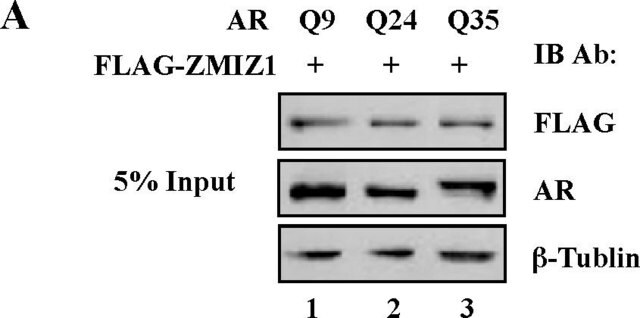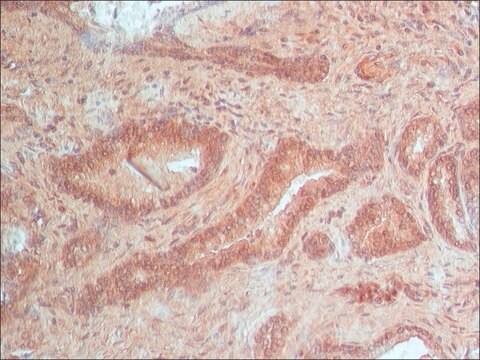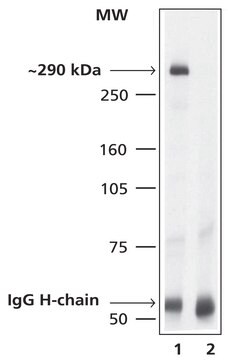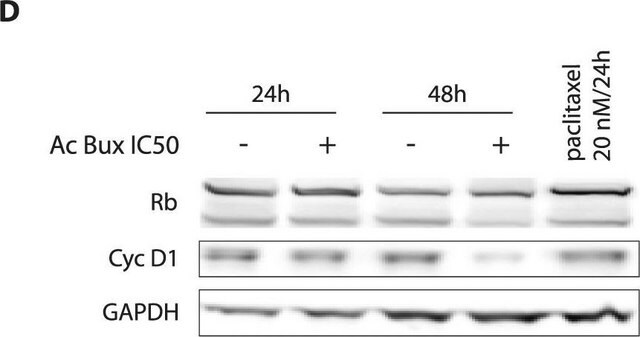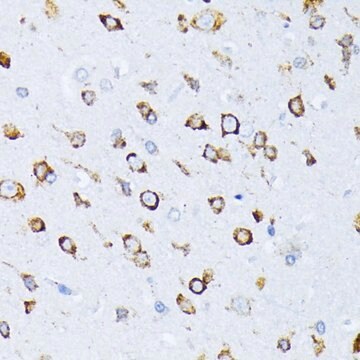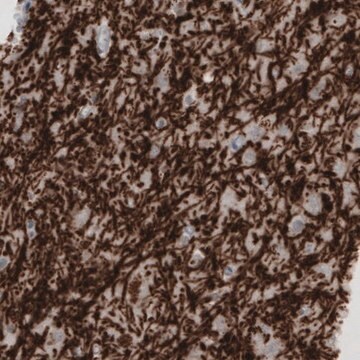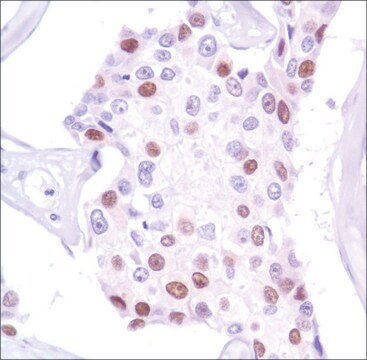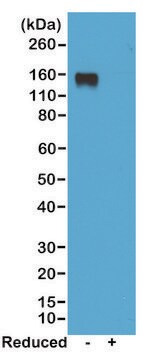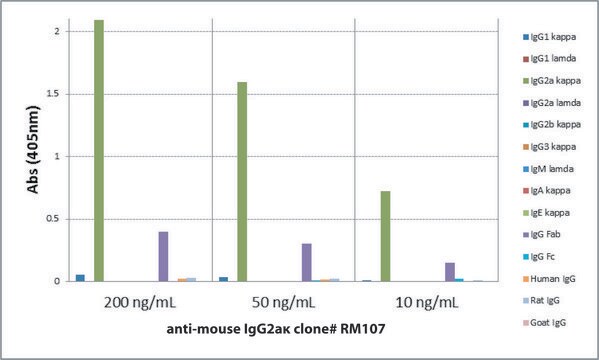SAB5500165
Anti-Progesterone Receptor antibody, Rabbit monoclonal
recombinant, expressed in proprietary host, clone SP2, tissue culture supernatant
Autenticatiper visualizzare i prezzi riservati alla tua organizzazione & contrattuali
About This Item
Codice UNSPSC:
12352203
NACRES:
NA.41
Prodotti consigliati
Origine biologica
rabbit
Livello qualitativo
Ricombinante
expressed in proprietary host
Coniugato
unconjugated
Forma dell’anticorpo
tissue culture supernatant
Tipo di anticorpo
primary antibodies
Clone
SP2, monoclonal
Reattività contro le specie
human (tested)
Reattività contro le specie (prevista in base all’omologia)
bovine, rabbit, pig
tecniche
immunohistochemistry: 1:400
Isotipo
IgG
N° accesso UniProt
Condizioni di spedizione
wet ice
Temperatura di conservazione
2-8°C
modifica post-traduzionali bersaglio
unmodified
Informazioni sul gene
human ... PGR(5241)
Descrizione generale
The progesterone receptor (PgR) is an estrogen-regulated protein. It has been proposed that expression of PgR determination indicates a responsive estrogen receptor (ER) pathway. A number of studies have shown that PgR determination provides supplementary information to ER.
Progesterone receptor (PGR) belongs to the steroid/thyroid hormone receptor family of ligand-activated transcription factors. It possesses the amino-terminal AF1 region, the central DNA-binding domain (DBD) and the carboxyl-terminal ligand- binding domain (LBD). The PGR gene is localized on human chromosome 11q22.1.
Progesterone receptor (PGR) belongs to the steroid/thyroid hormone receptor family of ligand-activated transcription factors. It possesses the amino-terminal AF1 region, the central DNA-binding domain (DBD) and the carboxyl-terminal ligand- binding domain (LBD). The PGR gene is localized on human chromosome 11q22.1.
Immunogeno
Recombinant protein encoding aa 412-526 of human progesterone receptor.
Azioni biochim/fisiol
Progesterone receptor (PGR) functions as a transcription factor,
which modulates the transcription of target genes in response to progesterone and other hormones. It is phosphorylated on multiple sites and at times, the phosphorylation changes according to the hormone involved. During hormone unavailability, PGR is bound to heat shock proteins. When the ligand binds, it causes the release of PGR from heat shock proteins. It is then translocated to the nucleus, where it binds to its DNA response elements (SREs) and to the components of the transcription machinery. PGR also binds to chromatin templates and results in chromatin remodeling adjacent to the PGR-binding sites.
which modulates the transcription of target genes in response to progesterone and other hormones. It is phosphorylated on multiple sites and at times, the phosphorylation changes according to the hormone involved. During hormone unavailability, PGR is bound to heat shock proteins. When the ligand binds, it causes the release of PGR from heat shock proteins. It is then translocated to the nucleus, where it binds to its DNA response elements (SREs) and to the components of the transcription machinery. PGR also binds to chromatin templates and results in chromatin remodeling adjacent to the PGR-binding sites.
Caratteristiche e vantaggi
Evaluate our antibodies with complete peace of mind. If the antibody does not perform in your application, we will issue a full credit or replacement antibody. Learn more.
Stato fisico
0.1 ml rabbit monoclonal antibody supplied as tissue culture supernatant in TBS/1% BSA buffer pH 7.5 with less than 0.1% sodium azide.
Esclusione di responsabilità
Unless otherwise stated in our catalog or other company documentation accompanying the product(s), our products are intended for research use only and are not to be used for any other purpose, which includes but is not limited to, unauthorized commercial uses, in vitro diagnostic uses, ex vivo or in vivo therapeutic uses or any type of consumption or application to humans or animals.
Non trovi il prodotto giusto?
Prova il nostro Motore di ricerca dei prodotti.
Codice della classe di stoccaggio
10 - Combustible liquids
Classe di pericolosità dell'acqua (WGK)
WGK 2
Punto d’infiammabilità (°F)
Not applicable
Punto d’infiammabilità (°C)
Not applicable
Scegli una delle versioni più recenti:
Possiedi già questo prodotto?
I documenti relativi ai prodotti acquistati recentemente sono disponibili nell’Archivio dei documenti.
Jake J Reske et al.
Human molecular genetics, 29(20), 3412-3430 (2020-10-20)
Although ARID1A mutations are a hallmark feature, mutations in other SWI/SNF (SWItch/Sucrose Non-Fermentable) chromatin remodeling subunits are also observed in endometrial neoplasms. Here, we interrogated the roles of Brahma/SWI2-related gene 1 (BRG1, SMARCA4), the SWI/SNF catalytic subunit, in the endometrial
Steroid receptor coactivator-1 (SRC-1) enhances ligand-dependent and receptor-dependent cell-free transcription of chromatin.
Liu Z, et al.
Proceedings of the National Academy of Sciences of the USA, 96(17), 9485-9490 (1999)
Olivia Jeong et al.
International journal of molecular sciences, 23(23) (2022-12-12)
Women with complex atypical hyperplasia (CAH) or early-stage endometrioid endometrial cancer (EEC) are candidates for fertility preservation. The most common approach is progesterone (P4) therapy and deferral of hysterectomy until after completion of childbearing. However, P4 therapy response rates vary
Phosphorylation of human progesterone receptor by cyclin-dependent kinase 2 on three sites that are authentic basal phosphorylation sites in vivo.
Zhang Y, et al.
Molecular Endocrinology, 11(6), 823-832 (1997)
Phosphorylation of human progesterone receptor by cyclin-dependent kinase 2 on three sites that are authentic basal phosphorylation sites in vivo.
Y Zhang
Molecular Endocrinology, 11(6), 823-832 (1997)
Il team dei nostri ricercatori vanta grande esperienza in tutte le aree della ricerca quali Life Science, scienza dei materiali, sintesi chimica, cromatografia, discipline analitiche, ecc..
Contatta l'Assistenza Tecnica.